Why Are Cats Scared Of A Cucumber?
Cats often fear cucumbers because they mistake them for predators or unexpected obstacles. The sudden appearance of a cucumber startles them due to their instinctive response to potential threats.
Cats are creatures of habit and keen observers of their environment. Any unexpected change can trigger their startle response, a survival mechanism vital in the wild. Due to their shape and size, cucumbers may resemble snakes to a cat, which are natural enemies.
This mistaken identity can cause a cat to jump or flee in fear. Videos showing cats scared of cucumbers went viral online, prompting many to play similar pranks on their pets. However, this trend has faced criticism from animal welfare advocates who stress that intentionally scaring cats can cause stress, anxiety, or injury. Understanding a cat’s perception and respecting its sense of security is crucial to ensuring its well-being and maintaining a trustful relationship with your feline friend.
The Viral Cucumber Scare

The Viral Cucumber Scare has taken the internet by storm, with countless videos spurring both laughter and curiosity among viewers. This online sensation involves the unexpected reaction cats exhibit when encountering a cucumber, presumably placing it behind them while they eat. The startled responses have raised questions about the underlying reasons cats demonstrate such behavior and the potential stress it may cause to our feline friends.
Reflection On The Widespread Social Media Trend
Social media channels buzzed with these cucumber surprise videos, recording millions of views, shares, and spirited discussions. Audiences often humorously reacted to the jumpy cats leaping away from the seemingly innocent cucumbers. Yet, a deeper look into the trend reveals potential welfare concerns and prompts a conversation on responsible pet ownership. The phenomenon, attracting pet lovers and novices alike, inadvertently turned into an educational moment on feline behavior and their perception of the world.
Brief Account Of Cats’ Reactions In Viral Videos
Video compilations showcase a variety of cats reacting with instinctive alarm, featuring jumps, sprints, and tactical retreats. These reactions occur when the pets notice the cucumber upon turning around after being engrossed in their meal. Experts have weighed in on the phenomenon, suggesting that the sudden appearance of an object in what a cat considers a safe and secure space is the primary trigger for the flight response—a behavior rooted in feline survival instincts designed to protect them from potential ambush predators.
- Initial Unawareness: Cats are initially oblivious to the cucumber’s presence.
- Sudden Encounter: The unexpected sight of the object upon completion of their meal triggers a surprise response.
- Instinctive Reaction: This instinctual behavior is deeply embedded within the feline psyche, akin to their ancestors in the wild.
Understanding Feline Sensory Perception

Cats are often seen as mysterious and elusive creatures, with behaviors that sometimes puzzle even the most devoted pet parents. One peculiar reaction that has garnered widespread attention is the seemingly inexplicable fear cats exhibit when they encounter a cucumber. To understand this phenomenon, one must delve into the complexities of feline sensory perception. This encompasses not only what cats see but also how they interpret their surroundings and react to the unknown.
Exploration Of Cats’ Visual And Instinctual Triggers
Cats possess a unique visual system that differentiates them from humans. Their eyes are adept at detecting motion and spotting the slightest movement, honing their skills as natural predators. This heightened sensitivity, combined with an instinctual wariness of sudden changes in their environment, can lead to dramatic reactions. When a cucumber is stealthily placed behind a cat, it resembles a snake at first glance, triggering an innate fear response. Predatory instincts may kick in, and the cat’s immediate reaction is often to jump or flee from the potential threat.
The colors and shape of the cucumber might not exactly resemble those of a predator, but what matters most is the surprise element and the potential threat it represents in the cat’s peripheral vision. The combination of unfamiliarity and placement without the cat’s knowledge can cause a surge of adrenaline, pushing the cat into a heightened state of alertness.
How Cats Process Unfamiliar Objects
Cats are naturally curious yet cautious creatures. Their approach to unfamiliar objects is a nuanced process, often involving a series of sensory evaluations. When encountering something new, cats typically use a multi-sensory investigative strategy. This may include:
- Observing from a distance
- Approaching slowly
- Sniffing to gather olfactory information
- Whisker feedback for spatial awareness
- Touching with paws to test texture and stability
Without this step-by-step examination method, an object like a cucumber, placed suddenly behind them, bypasses their usual analytical process. This disruption in their expected environmental consistency triggers stress and potential panic. For cats, the presence of a new and unexpected item in a space they consider safe, such as their feeding area, can be particularly distressing.
Ultimately, feline reactions to cucumbers or similarly unexpected stimuli highlight the sophisticated nature of cat sensory perception and cognitive processing. While the viral videos of cats jumping at cucumbers may seem humorous, pet owners need to understand the underlying mechanisms at play. Respecting the sensitive nature of our feline friends ensures we create a safe and serene environment for them.
Why Are Cats Scared Of A Cucumber?
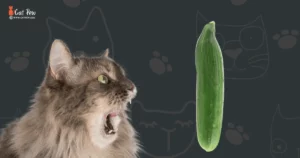
Anecdotal evidence and viral videos have popularized the notion that cats are innately scared of cucumbers. But why are cats scared of a cucumber? Is it the shape, the color, or some hidden cucumber essence that triggers this fear? The answers may be surprising and have more to do with feline instincts than the cucumber itself.
Inspection Of The Shape And Size Variables
A theory suggests that the shape and size of cucumbers trigger a fear response in cats. When placed sneakily behind an unsuspecting cat—usually while they are eating—their first sight of this elongated green object can prompt a startled reaction. This shape could subconsciously resemble a snake, an ancestral threat to cats in the wild. This intuitive fear of snakes could be deeply ingrained in a cat’s psyche, causing them to jump or flee when they suddenly see something snake-like.
The Element Of Surprise And Natural Instincts
The reaction cats have to cucumbers is likely not about the vegetable itself but rather the element of surprise. When questioning, “What happens if you put a cucumber near a cat?” the outcome largely depends on how the cucumber is introduced to them. Cats are highly sensitive to environmental changes, primarily due to their status as both predators and prey. An unexpected object appearing while they have their guard down during feeding times can trigger their ‘fight or flight’ response. This reaction is a protective instinct towards potential danger. If you surprise a cat with a cucumber, you’re likely activating its natural instincts to be wary of the unexpected.
Defensive Behaviors In Felines
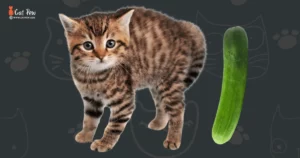
The viral videos of cats leaping high into the air at the sight of cucumber may elicit laughter from viewers. However, they also shed light on the intricate defensive mechanisms hardwired into feline behavior. While it’s amusing on screen, understanding why cats showcase these dramatic reactions can teach us much about their innate nature and needs.
Explanation Of Natural Predatory And Survival Instincts
Cats are natural predators, evolved to be highly sensitive to their surroundings—a trait that serves both in hunting and evading threats. This biological heritage influences much of their behavior. For a domestic cat, encountering an unexpected object like a cucumber triggers a deep-seated instinctual response.
- Camouflage: Their predators, as well as prey, often blend into the environment. An unrecognized object could represent a lurking danger.
- Flight over Fight: Cats prefer avoiding confrontation if possible, and their first instinct is often to escape from potential threats.
- Surprise Factor: Cats enjoy a controlled environment. A sudden cucumber appearance mimics the unexpected nature of a predator’s attack.
Analysis Of The Fight Or Flight Response In Cats
The “fight or flight” response in cats is a fundamental reaction essential to their survival. When confronted with a perceived threat — like an ominous cucumber — their sympathetic nervous system rapidly decides whether to stand their ground and fight or flee. This immediate reaction involves several physiological changes:
| Response Type | Physiological Change |
|---|---|
| Fight |
|
| Flight |
|
To conclude, when startled by a cucumber, the alarm cats exhibit isn’t just a quirky internet meme; it demonstrates their complex survival strategies. By recognizing these behaviors, cat owners can better understand and appreciate the primal instincts that drive their feline friends.
Mimicry Of Snakes: A Theory
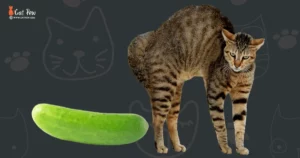
Delving into the world of feline fears brings one to a curious phenomenon that has intrigued both cat lovers and internet enthusiasts alike: why do cats display such an exaggerated startle response to cucumbers? One theory that stands out in explaining this behavior is the Mimicry of Snakes. This theory posits that the sudden appearance of a cucumber may trigger a cat’s innate fear of snakes, thus eliciting a dramatic reaction.
Comparison Between Cucumbers And Potential Threats
The resemblance between a cucumber and a snake may not be obvious to a human observer at first glance, but the similarities might be striking for a cat. Both are long, cylindrical, and typically rest on the ground. To a cat that’s not expecting to encounter an object of this shape, a cucumber can appear quite suddenly, akin to how a stealthy snake might.
| Cucumber | Snake |
|---|---|
| Long and cylindrical | Long and flexible body |
| Rest on the ground | Slithers across the ground |
| Typically green | Often green or brown, blending with natural habitats |
| Static unless moved | Can be motionless or suddenly move when threatened |
Discussion Of Evolutionary Aversion To Snake-like Shapes
Cats’ ancestors lived in environments where predator avoidance was crucial for survival. Quick reactions to potential threats could mean the difference between life and death. Therefore, the evolutionary aversion to snake-like shapes is deeply ingrained in a cat’s psyche. This instinctive fear response is known as a defensive mechanism against venomous predators that share the serpentine form.
- Indicator of genetic predisposition: Cats may be hardwired to react swiftly to elongated, ground-level objects resembling snakes.
- Survival adaptation: Avoidance behaviors are passed down through generations, becoming inherent in the species.
- Instantaneous reflex action: The unexpected presence of a cucumber taps into this survival instinct, causing an immediate ‘fight or flight’ response.
Therefore, while cucumber is harmless to a cat, it may unwittingly mirror the characteristics of a much more significant threat: a lurking serpent. Understanding this view helps decipher the perplexing reaction cats often exhibit when encountering this innocuous vegetable.
Setting Up A Safe Environment For Cats
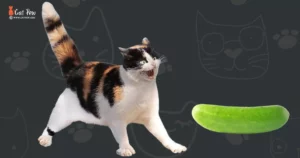
Welcome to our discussion on creating a nurturing and safe space for our feline companions. Understanding why cats may display fear towards seemingly harmless objects like cucumbers involves unraveling their instincts and needs. It’s not just about removing the offending cucumber; it’s about fostering an environment where cats feel protected and at ease. Let’s delve into the critical aspects of respecting your cat’s personal space and the repercussions of exposing them to intentional fright.
Importance Of Respecting The Cat’s Space And Safety
Cats cherish their surroundings and rely on stability to feel secure. An environment that supports their well-being is paramount. To ensure this:
- Minimize sudden changes in their living area, as cats are highly sensitive to new objects and alterations in their territory.
- Observe your cat’s behavior to learn where they prefer to spend time. Designate these areas as ‘safe zones’ where they can retreat without disturbance.
- Provide hideaways and perches, which are vital for your cat’s sense of security. They offer vantage points and secluded spots to observe or rest.
Consequences Of Intentionally Scaring Cats
Startling a cat on purpose can have lasting negative implications. These might include:
- Triggering stress and anxiety which can manifest in a variety of health and behavioral issues.
- Straining the bond between you and your pet. Trust is a cornerstone of your relationship, and scaring them can severely damage that trust.
- Cats may become defensively aggressive or scared, altering their natural disposition and potentially leading to danger for the cat and its owners.
Remember, maintaining a safe and respectful atmosphere is not just about what you introduce to your cat’s environment but also about what you should avoid. Objects like cucumbers are perceived as potential threats because they trigger a cat’s surprise reflex, which can lead to unnecessary stress. By being mindful of our actions and the items we place in our cat’s environment, we contribute to their emotional and physical well-being.
Feline Experts Weigh In
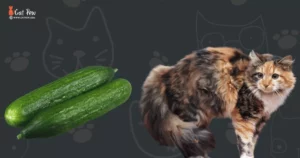
The internet brims with videos of cats leaping into the air at the sight of a cucumber, prompting a cascade of amusement and concern among cat lovers. But what makes this phenomenon so widespread? Feline Experts Weigh In on the peculiar feline-cucumber relationship, shedding light on the psychological and instinctual factors at play. Understanding why cats respond this way can help cat owners ensure the emotional well-being of their furry companions.
Insights From Veterinarians And Animal Behaviorists
Seeking clarity, we delve into the minds of our feline friends with insights from veterinarians and animal behaviorists. These experts suggest that the cucumbers trigger a cat’s natural startle reflex. Often mistaken for a predator, like a snake, the sudden appearance of a cucumber can send a cat into alarm mode. Such an object, typically sneaking into their peripheral vision during a vulnerable moment of eating, is perceived as a potential threat.
- High sensitivity to abrupt changes in the environment
- Mistaken identity of cucumbers for snakes or predators
- The instinct to protect themselves from the unknown
Stealth and strategy are essential in a cat’s world, and unexpected items can invoke a deep-rooted sense of caution. The sight of a cucumber taps into the cat’s survival instincts, prompting an immediate and often exaggerated response.
Long-term Effects Of Fear-inducing Events On Cats
While a singular event may seem harmless, repetitive exposure to fear-inducing scenarios can impact a cat’s long-term well-being. Stress and anxiety levels may rise, potentially leading to behavioral changes and health issues. Animal behaviorists emphasize the importance of a stable and predictable environment for cats to reduce stress and maintain mental health.
| Concern | Impact on Cat |
|---|---|
| Stressful environments | Increased anxiety and potential behavioral issues |
| Unexpected scary events | Potential development of phobias or long-term stress |
Accordingly, introducing sudden changes or frightening stimuli, even if seemingly innocuous, can lead to a mistrustful and skittish pet. Thus, experts discourage pranking pets with cucumbers, as these pranks could cause psychological trauma and strain the precious bond between cats and humans.
Creating Positive Encounters With Objects

When it comes to the famed fear of cucumbers in cats, it’s not so much about the vegetable itself but more about how cats perceive unexpected objects in their environment. Creating positive encounters with objects is crucial for a cat’s sense of security and well-being. A cat’s environment should be a safe space where newly introduced items don’t trigger stress or fear. Let’s explore how cat owners can ensure their furry friends are comfortable and curious rather than anxious and scared.
Tips For Introducing New Items To Cats
Introducing new items to cats can be a delicate task. Here are some strategies to ensure a smooth introduction:
- Gradual introduction: Present the new object at a distance first, allowing the cat to acknowledge its presence without feeling overwhelmed.
- Associate with positivity: Pair the new item with treats or playtime, creating a positive association in the cat’s mind.
- Use familiar scents: Rub the item with a blanket or toy that your cat frequently uses to transfer their scent onto the object.
- Observe body language: Be attentive to your cat’s reactions, and proceed only if they show signs of curiosity or neutrality.
- Never force interaction: Let your cat approach the new object in their own time; forcing an interaction can lead to a phobic response.
Methods Of Ensuring A Cat-friendly Home And Surroundings
Creating a cat-friendly home and surroundings is vital to prevent fear and stress. Consider the following methods:
- Safe zones: Establish areas in the home where your cat can retreat to if they feel scared or overwhelmed by new objects or experiences.
- Consistent environment: Maintain a consistent setup in your home to help cats feel in control of their territory.
- Interactive toys: Offer interactive toys that distract and engage your cat, helping to reduce anxiety when new items are introduced.
- Environmental enrichment: Include cat trees, shelves, or window seats to increase the vertical space, providing physical and mental stimulation.
- Be patient: Understand that each cat has a unique personality. Some may adjust quickly, while others need more time to accept new items.
Frequently Asked Questions For Why Are Cats Scared Of A Cucumber
Why Are Cats Scared Of A Cucumber?
Cats are startled by cucumbers because they resemble snakes, triggering a natural fear response.
Why Do Cats Fear Cucumbers?
Cats are startled by cucumbers because they often mistake them for predators. The sudden appearance of an unfamiliar object triggers their instinctive flight response. As stealth hunters, cats are naturally wary of potential threats suddenly appearing without warning.
Does Every Cat Get Scared Of Cucumbers?
No, not all cats are scared of cucumbers. Reactions can vary based on individual personality and past experiences.
Can Cucumbers Harm Cats Physically?
No, cucumbers are not physically harmful to cats. However, the stress and anxiety caused by the scare can lead to behavior issues or injuries if the cat attempts a panicked escape.
Why Do Cucumbers Upset Cats?
Cucumbers can startle cats because of their unexpected appearance.
What Happens If You Put A Cucumber Near A Cat?
Cats may be startled by the sudden appearance of a cucumber and react with fear or aggression.
Will Cucumbers Really Keep Cats Away?
No, cucumbers do not have any proven deterrent effect on cats.
What’s The Psychology Behind Cats’ Fear Of Cucumbers?
The psychological aspect of cats’ fear of cucumbers is largely due to the element of surprise. Cats have a strong survival instinct; an unexpected object can initiate a fear response due to its association with potential danger.
How Should You Introduce New Objects To Cats?
Introduce new objects to cats gradually and in a non-threatening manner. Allow them to discover items on time, ensuring they feel safe. This helps to minimize stress and prevent fear responses.
Can I Train My Cat To Not Be Afraid Of Cucumbers?
While some behavior modification techniques may help, it’s generally best to avoid intentionally exposing your cat to things that cause fear.
Conclusion Of Why Are Cats Scared Of A Cucumber
Cats often exhibit a fear of cucumbers, but it’s not the vegetable itself—they’re responding to surprise. Their instinct alerts them to potential threats, like snakes. For cat owners, understanding this behavior is key. To ensure a stress-free environment, always introduce new items gently and with consideration for your feline friend’s wellbeing.

Winston
I'm Winston, the author of this feline-focused (Catpew.com) blog . My love for cats goes back to my childhood, when I spent countless hours playing with my family's tabby, Mittens. This furry friend instilled in me a deep appreciation for the unique personalities, playful nature, and unconditional love that cats offer.

